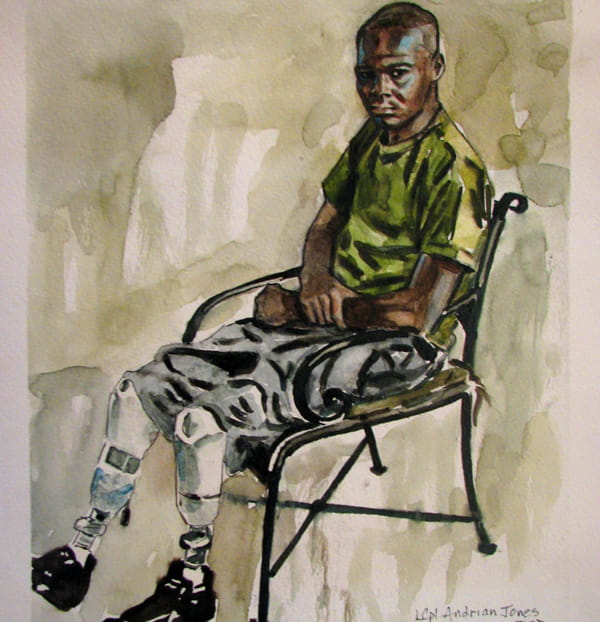Imaging War: New Drexel Course Explores the Way War Has Been Portrayed Through Art and Media

- No link between acetaminophen use during pregnancy and children's autism risk
- Drexel Recognizes Gregory E. Deavens, CPA, CGMA as Business Leader of the Year
- $15 Million Gift from Howley Foundation Expands Drexel Scholarship Program for Local Graduates
- Drexel’s Pearlstein Gallery Offers Spring Exhibitions Centered on the Healing Properties of Art and Creative Works

From the Battle of Marathon in 490 B.C. through current-day wars in Iraq and Afghanistan, our view of war has been indelibly shaped by the images we see of the conflicts and their aftermath. A new fall course at Drexel University, entitled “Imaging War,” examines how the subject of war has been depicted in media ranging from photography to television to video games.
Through discussions on the ways war is conveyed in film, how television portrays the war on terror and the war on drugs, how video games depict war and combat and how painting and sculpture have immortalized our centuries-old propensity for going into battle, the course will provide a dynamic look at the ways in which war has been represented and communicated throughout the years.
The class is taught by Karen Curry, executive director of the Kal and Lucille Rudman Institute for Entertainment Industry Studies in the Antoinette Westphal College of Media Arts & Design and a former NBC News and CNN producer; Hana Iverson, a visiting professor in the Westphal College; and Elliot Panek, a visiting professor in the Pennoni Honors College.
Each Tuesday evening class session will begin with a presentation by a guest speaker(s), followed by group discussion about the topic. Speakers will include award-winning photojournalists and correspondents, combat artists and network news executives. All of the guest lectures are free and open to the public.
Highlights include a presentation by Pulitzer prize-winning playwright Donald Margulies, whose searing play Time Stands Still brings the intensity of covering war to life. Regarding his upcoming Drexel visit, Margulies said “When Time Stands Still was first produced, in 2009, the war in Iraq was still surging. Now, four years later, horrific conflicts in Africa and the Middle East dominate the news, sadly making the play seem as current as when it was created.”
Photojournalist and documentarian Brian Palmer and Al Jazeera America correspondent Sheila MacVicar, both veteran conflict journalists, join Margulies on Thursday, Oct. 17 at 7 p.m. in Bossone Research Center’s Mitchell Auditorium (3140 Market Street). Time Stands Still was nominated for two Tony Awards for Best Play and Best Performance by leading actress Laura Linney. Nick Anselmo, Annette Kaplafka and Bruce Graham will perform scenes from the play, with Graham reprising the role he played in the Act II Playhouse and Delaware Theater Company productions of Time Stands Still. A reception will take place after the discussion.
Full schedule of guest speakers: (all events take place on Tuesday evenings at 6:30 p.m. in Room 104 of the Papadakis Integrated Sciences Building at 33rd and Chestnut Streets, unless otherwise stated).
- Sept. 24 War/Photography
Images of Armed Conflict and Its Aftermath
Anne Wilkes Tucker, curator, Museum of Fine Arts, Houston
- Oct.1 Reel War
Ian Abrams, director of Westphal’s Screenwriting Program, on how
cinema portrays war
- Oct. 8 The War Was Televised
Ed Fouhy, former CBS News Saigon bureau chief
Eason Jordan, former CNN chief news executive
- Oct. 15 How We Remember
James Young, UMass at Amherst, renowned scholar on memory and war
A.J. Drexel Picture Library, Main Building, 3141 Chestnut St.
- Oct. 17 An Evening with Donald Margulies
(Thursday, 7 p.m.) Discussion of Tony-nominated play Time Stands Still
Pulitzer Prize winning playwright Donald Margulies, filmmaker Brian
Palmer and Al Jazeera America correspondent Sheila MacVicar
Bossone’s Mitchell Auditorium (3140 Market St.)
Reception to follow
- Oct. 29 Combat Art
Former U.S. Marine and combat artist Mike Fay and celebrated civilian
illustrator Victor Juhasz, whose work has appeared in the New York
Times, Wall Street Journal, Newsweek, Rolling Stone and other major outlets
Opening of The Joe Bonham Project exhibit, which will be on display through
Veteran's Day.
Fay and Juhasz, along with other military and civilian illustrators, have put
together The Joe Bonham Project – a collection of portraits of wounded
warriors. Realizing that although these soldiers may leave the front, they
don’t leave the war behind, these artists are committed to documenting
veterans as they recuperate back home. The project is named for Joe Bonham,
the limbless, faceless protagonist of Johnny Got His Gun, Dalton Trumbo’s
1939 antiwar novel. The project was featured in the New York Times.
Hahnemann Hospital Library (245 N. 15th Street)
Reception to follow
- Nov. 5 Prime Time War on Drugs and Terror
How prime time television portrays the war on terror and the war on drugs
Johanna Blakley, deputy director of the Norman Lear Center, USC Annenberg
School for Communication and Journalism
- Nov. 12 Under Fire: Journalists in Combat
Screening of this 2013 Peabody Award winning film
Psychiatrist Dr. Anthony Feinstein, leading scholar on the effects of combat
on journalists and the film’s producer is joined by Pulitzer Prize-winning
photojournalist Paul Watson, who is featured in the film
- Nov. 19 Video Games and War
Dr. Matthew Payne, an assistant professor in the Department of
Telecommunications and Film at the University of Alabama, who specializes in
video games and interactive media and media representations of war

|
A piece from The Joe Bonham Project |
Students will be graded on a combination of participation, homework assignments and a final project. For the final project, the class will be broken up into groups of three. Each of the groups will decide on a project based on the interests and skill set of the group that will incorporate the concepts that have been brought up in the course and develop them further. Projects could include a short film, photo essay, website or even a fully researched paper that would tackle one of the issues that they have found compelling in the class. The projects should reflect the students' abilities to synthesize what they absorbed from the speakers, the readings and screenings and apply that to images of war.
The course is offered as part of the Pennoni Honors College’s Great Works Symposium, a unique sequence of four interdisciplinary courses centered around a common theme each academic year. This year’s theme is “Media: Past, Present and Future,” and is sponsored by Drexel's Kal and Lucille Rudman Institute for Entertainment Industry Studies. Symposium series courses are open to all students regardless of their major.
The idea behind the symposium is to give students an opportunity to think about how their chosen field fits into an interdisciplinary topic and to interact with people they might not see too often during their normal course of study. Typically, a Great Works Symposium course contains students from every college or school at the University.
Courses coming in the winter, spring and summer terms will examine how television will handle the emergence of digital video platforms and other new competition, how people can be smart consumers of media in today’s age and how the two-way nature of digital media creates new possibilities.
Drexel News is produced by
University Marketing and Communications.